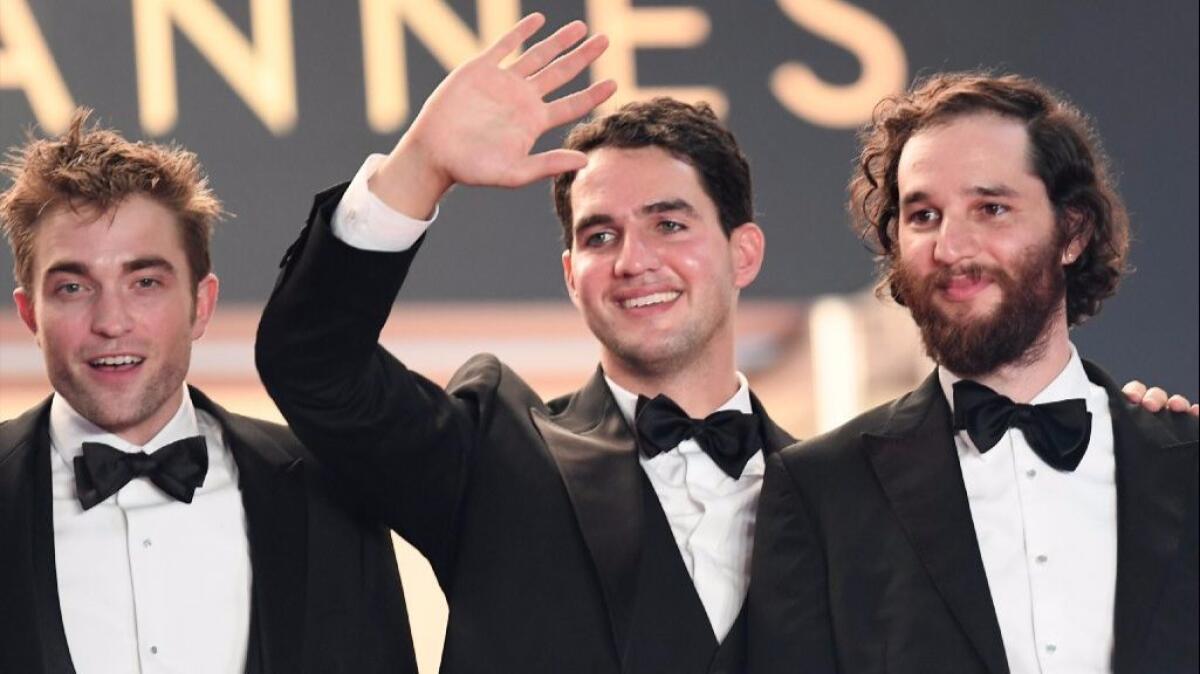Cannes 2017: ‘Good Time’ shakes up a modern festival by returning to the 1970s

- Share via
Reporting from CANNES, FRANCE — For the last decade, the New York filmmakers Josh and Benny Safdie have been making raw, low-budget movies, carving out a place in the U.S. indie film world but not much beyond that.
So you wouldn’t necessarily expect them to suddenly break out on the global stage of Cannes with a competition pot-stirrer.
And you really wouldn’t expect them to make that mark via … an homage to “Of Mice and Men” in the form of a social-realist chase picture?
Yet the Safdies, perennial outsiders, have perhaps the movie of this tres important cinema gathering: “Good Time,” a film about two criminal brothers from a Greek American family in the directors’ hometown of Queens, N.Y.
“We know nobody knows us and that we kind of live under a rock,” said Josh Safdie, 33 and hirsute, as he sat next to his sibling on a terrace at one of this festival’s swish hotels.
“Our best-known movie is probably [the basketball documentary] ‘Lenny Cooke.’ And no one knows we directed that,” added Benny, 31 and clean-shaven.
Such anonymity might not last long. Since it premiered Thursday, “Good Time” has become one of the most critically adored movies of the festival, attracting fans because of its tense thriller conceit — the action takes place almost entirely over the course of one night, rocketing from one event to the next — and its class-conscious overtones.
Benny Safdie also stars in the movie, as one of said brothers, opposite Robert Pattinson. A24, the “Moonlight” studio that shook up Cannes with another genre movie earlier in the week, will bring out “Good Time” this summer.
The plot centers on Connie (Pattinson), a caretaker of sorts for his brother Nick (Safdie), who suffers from some mental handicaps. Connie dreams of a better life for the two of them, so he orchestrates a bank robbery he thinks could fulfill those fat-of-the-land ambitions. A street hustler type, Connie is nonetheless very devoted to Nick, which is why when things go awry during the robbery and Nick ends up behind bars, Connie goes to great creative and criminal lengths to break him out.
What follows is a bleak but rollicking movie that will evoke, in turns, desperate-fugitive pieces like “The Running Man” (or “The Fugitive”), combined with the streetwise grit of 1970s New York crime pictures like “Dog Day Afternoon.”
“We wanted to take the tools we learned making our other movies — the tools in creating characters and atmosphere — and put it in a genre movie,” said Benny Safdie, a statement that could have come right out of the Sidney Lumet playbook.
“I don’t know that we wanted to make a throwback — we wanted the movie to speak to America in 2017,” Josh Safdie said. “But we did want to make a piece of pulp, a piece of termite art, that felt truly dangerous.”
See the most-read stories in Entertainment this hour »

The film is also notable for its speed; exposition is at a minimum, and the narrative events are many.
“We wanted to ratchet up the pace to 25 — if it didn’t go to plot or character, it was gone,” Benny Safdie said. “Pace is in a sense a character.”
They aimed for 99 minutes and came up just short — or long. (It’s 100.)
The Safdies had been toiling on their long-standing passion project, “Uncut Gems,” a drama set in the jewelry world (they still aim to shoot that early next year), when Pattinson got in touch to collaborate.
The “Twilight” pinup had seen the Safdies’ heroin-world story, “Heaven Knows What,” and thought their rough-hewn sensibility is what he was needing in this new career phase. The Safdies didn’t think there was a meaty role for Pattinson in “Gems.” So they began writing a new piece for him.
The star’s involvement began attracting other actors and financing; in turn, the Safdies gave the former Edward Cullen an implicit street cred. Pattinson was so keen to dive into the film’s street hustle world that he would visit New York prisons with the Safdies in the name of research. (He would go in character, in the admittedly unlikely event an inmate recognized him from “Twilight.”)
It’s impossible to avoid the question of class in the story of Connie and Nick, who just want a shot at middle-class stability and find even basic opportunities closed off to them. In a way their economic disadvantages force them to acts of criminality in the first place. What’s notable is that Connie doesn’t see himself as working-class, and when he encounters another criminal, he takes pains to distinguish himself as someone made from more elite, substantive cloth.
The American dream and the way working-class elements are increasingly cut off from it are in the news, and it makes the social realist notes in the movie very timely. “We were very interested in people on any side of the spectrum who’ve been disenfranchised,” Benny Safdie said.
“The trap of life,” Josh Safdie said, “is that sometimes there’s a fate you can’t avoid.”
Just 20 months apart, the brothers have both a very close and very frictional relationship. (Professionally, Josh writes more and Benny does the larger share of the editing. The two direct together.)
They said that they didn’t intend to make a movie about sibling relationships, but it’s hard not to feel a subconscious channeling of their own experience. Connie and Nick are bonded in part because of their larger family’s dysfunction, mirroring the Safdies’ own tumultuous upbringing as children of young parents who divorced while both were still toddlers.
Still, they say they never talk about the subject and are at times even surprised when people point out the connection.
“Rob would always ask us about it. And maybe it bled into the movie. But in a way we don’t consider this a movie about brothers,” Josh Safdie said.
“It’s just second nature,” added Benny.

Twitter: @ZeitchikLAT
More to Read
Only good movies
Get the Indie Focus newsletter, Mark Olsen's weekly guide to the world of cinema.
You may occasionally receive promotional content from the Los Angeles Times.









